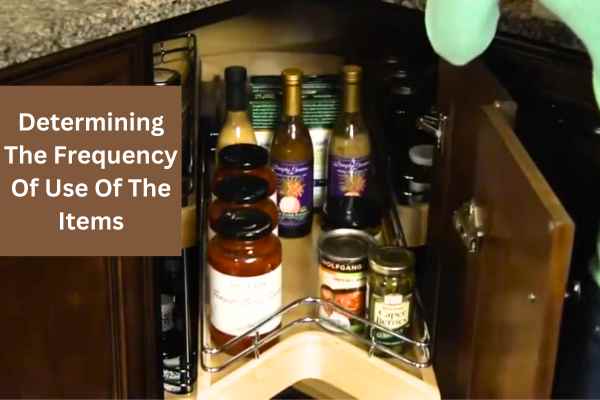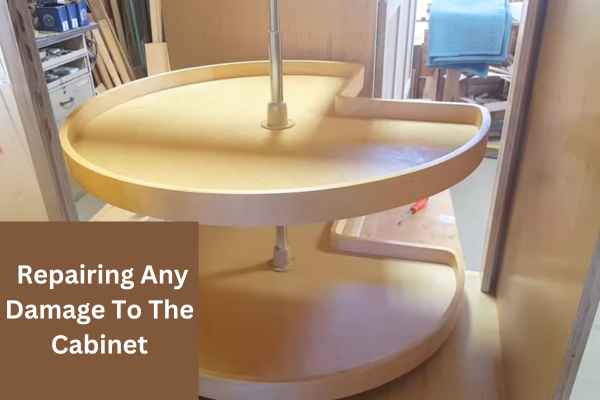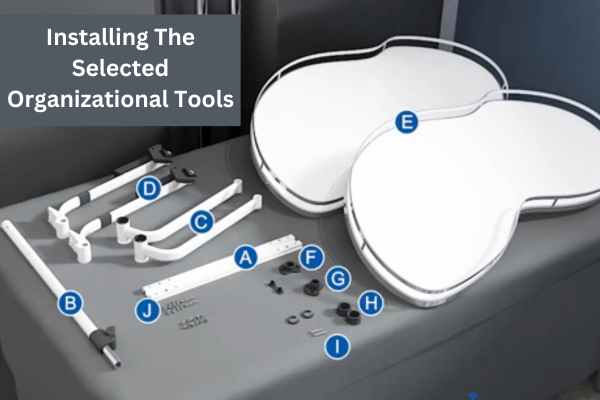This article aims to provide practical tips on how to organize a Lazy Susan cabinet, which is a popular storage option in many kitchens. Organizing the cabinet is crucial as it saves time and reduces stress when searching for items, prevents item from getting lost or forgotten, and improves the overall appearance of the kitchen. The tips include sorting and categorizing item, using storage containers, considering your needs, maximizing space, and regularly cleaning and maintaining the cabinet. By following these tips, you can make the most of your Lazy Susan cabinet and keep your kitchen organized and functional.
What Is A Lazy Susan Cabinet?

A Lazy Susan cabinet is a type of storage cabinet commonly found in kitchens that features a rotating turntable or shelf. The turntable allows for easy access to items stored in the cabinet without having to reach to the back or move item out of the way. Lazy Susan cabinets come in various shapes and sizes and can be used to store a variety of items such as dishes, pots and pans, and small appliances. They are a popular storage option in kitchens as they maximize space and make it easier to organize and access item.
The Benefit Of Organize A Lazy Susan Cabinet
- Saves time and reduces stress when searching for items.
- Helps prevent item from getting lost or forgotten, reducing the risk of clutter and waste.
- Maximizes the use of cabinet space, allowing you to store more items in an organized manner.
- Improves the overall appearance of your kitchen, making it more inviting and enjoyable to spend time in.
- Makes it easier to access items, as they are not buried behind other item in the cabinet.
- Reduces the risk of accidents or damage to item stored in the cabinets.
- Allows you to keep similar items together, making it easier to find and use them.
- Helps you identify items that are no longer needed or expired, allowing you to discard them and free up space in the cabinet.
- Increases your overall productivity in the kitchen, as you can quickly find and access the item you need.
- Provides a sense of accomplishment and satisfaction from having an organized and functional cabinets.
Assessing The Lazy Susan Cabinet
1. Examining The Size Of The Cabinet

When examining the size of the cabinet, consider the diameter and depth of the shelves. Make sure to account for the height of any tall items you plan to store in the cabinet, such as bottles or jars. Also, keep in mind any bulky kitchen tools, like stand mixers or blenders, that you may want to store in the cabinets. If you have a small or oddly-shaped cabinet, consider using storage containers that can be stacked or angled to make the most of the space.
2. Identifying The Items To Be Stored In The Cabinet

Identifying the items to be stored in the cabinets, take an inventory of all the item that you currently have and those that you anticipate acquiring in the future. This will help you determine how much space you need and what type of storage containers or organizers you may need. Consider the size and shape of each item and whether it will be stored best in a container, on a shelf, or on a turntable.
3. Determining The Frequency Of Use Of The Items

When determining the frequency of use of the items, think about how often you use each item and how accessible it needs to be. For example, items that are use frequently, such as spices or utensils, should stored in the most accessible spots. Items that are use less often, such as specialty kitchen tools or seasonal items, can stored in less accessible areas. Consider grouping item that are use together, such as baking supplies, near each other to make meal preparation easier.
4. Identifying Any Obstacles Or Limitations Of The Cabinet

Identifying any obstacles or limitations of the cabinets, consider the layout of the cabinets and how it affects the placement of item. For example, if the cabinets has a center pole, it may be difficult to store larger item or containers. You may also need to adjust the placement of items to prevent them from hitting the pole or interfering with the turntable. If the shelves have a fixed height, you may need to use stackable storage containers to maximize the space. Also, consider any weight limitations of the cabinets and place heavier item on the lower shelves or turntable to prevent damage or accidents.
Preparing The Lazy Susan Cabinets For Organization
1. Removing All Items From The Cabinet

To start, remove all items from the Susan cabinets. This will allow you to see exactly what you have and what needs to be organized. As you remove item, group them by category or type so that you can easily see what you have. This step will also help you determine what item you no longer need or use, which you can set aside to donate or dispose of.
2. Cleaning The Cabinet

Once the cabinet is empty, it’s time to give it a thorough cleaning. Use a damp cloth or sponge to wipe down the interior of the cabinets, including the shelves and the turntable. For tough stains or grease, use a mild cleaning solution. Make sure to dry the cabinets completely to prevent any moisture buildup. Cleaning the cabinets not only makes it more visually appealing but also helps prevent any bacteria or mold growth.
3. Repairing Any Damage To The Cabinet

Before you start organizing the item, take a moment to inspect the Susan cabinets for any damage. Check for loose screws or hinges, cracks in the shelves, or any other issues that may affect the cabinet’s stability or functionality. If there is any damage, make sure to repair it before proceeding with the organization process. This will prevent any further damage or accidents from occurring.
Choosing The Right Organizational Tools

1. Evaluating The Available Organizational Tools
There are several organizational tools that can be used to optimize a Susan cabinet. Some of the most common tools include turntables, tiered shelves, storage bins, and dividers. Each tool has its unique advantages and can be use in various ways to maximize the storage space of the cabinets.
A. Turntables
Turntables are the most popular tool for organizing a Susan cabinet. They come in various sizes and shapes and allow you to access items on the back of the cabinets without having to remove item in the front.
B. Tiered Shelves
Tiered shelves are useful for organizing items with different heights, such as spices or canned goods. They provide a more stable surface and prevent item from falling over.
C. Storage Bins
Storage bins are excellent for grouping item together and keeping them organized. They come in different sizes and can be easily labeled to help identify the contents.
D. Dividers
Dividers are useful for separating items that are stored together. They help to maximize space by preventing item from shifting or falling over.
2. Selecting The Appropriate Tools Based On The Items To Be Stored
When selecting organizational tools, it’s important to consider the types of item that will be stored in the cabinets. For example, turntables may be more useful for storing condiments and spices, while tiered shelves may be better suited for canned goods and bottles
3. Measuring The Cabinet To Ensure A Proper Fit Of The Tools
It’s essential to measure the Susan cabinets before purchasing any organizational tools. This ensures that the tools will fit the space and that there will be enough room to rotate the turntables or access the item on the shelves.
Organizing The Susan Cabinets
1. Installing The Selected Organizational Tools

Once you have chosen the appropriate organizational tools for your item, it’s time to install them. Make sure to follow the manufacturer’s instructions for each tool. Test the rotation of the Lazy Susan to ensure that the tools are install in a way that allows the Lazy Susan to spin freely.
2. Placing Items In The Cabinets In A Logical Order
When placing items in the Lazy Susan cabinets, it’s important to think about the most logical arrangement based on your needs. Consider grouping items by their function or frequency of use. For example, group baking supplies together on one shelf and cooking oils on another. Place item that are use more frequently at the front of the shelf for easy access.
3. Maximising The Use Of Vertical Space In The Cabinets
Maximizing the use of vertical space in your Lazy Susan cabinets are important for making the most of the available storage. Use tiered shelves to stack item and create additional storage space. Consider storing taller items on the top shelf and shorter item on the bottom shelf to make the most of the available space.
4. Testing The Functionality Of The Organizational Tools
After installing and arranging the item in your Susan, it’s important to test the functionality of the organizational tools. Rotate the Lazy Susan to make sure that the tools are secure and that the items are easily accessible. Make any necessary adjustments to ensure that the cabinet is functional and efficient.
Maintaining The Organized Lazy Susan Cabinets

1. Regularly Reviewing The Items
It’s a good idea to review the items in your Lazy Susan cabinets every few months. Check for any expired food items, duplicate item, or items that you no longer need. This will help keep the cabinets from becoming cluttered and will ensure that only necessary items are stored.
2. Re-Organizing This As Needed
As your storage needs change, it may become necessary to reorganize the items in your cabinets. If you find that certain items are not easily accessible, consider rearranging the organizational tools or moving items to a different shelf. You may also want to adjust the height of the shelves to accommodate larger or smaller items.
3. Cleaning It On A Regular Basis
Cleaning the cabinet on a regular basis will help keep it looking its best and functioning efficiently. Use a mild cleaner and a damp cloth or sponge to wipe down the shelves and organizational tools. Avoid using harsh chemicals or abrasive cleaners, which can damage the cabinets and its contents.
4. Avoiding Overloading
One of the biggest mistakes people make when organizing a Lazy Susan cabinets are overloading it. This can cause the cabinet to become difficult to rotate and can even damage the organizational tools. Make sure to leave some space between items and avoid storing heavy items on the upper shelves. You should also avoid storing items that are too tall or too wide for the cabinets, as this can also cause the cabinets to become difficult to rotate.
The Final Thoughts
Certainly, organizing a Lazy Susan cabinet is a simple yet effective way to optimize your storage space. By following the steps outlined in this article, you can effectively assess the size of your cabinet, identify the items to be stored, select appropriate organizational tools, and maintain the cabinet. Regularly reviewing the contents of the cabinet and avoiding overloading are key factors in maintaining an organized space. The benefits of proper organization and maintenance include increased efficiency, reduced frustration, and an aesthetically pleasing living space. So, take some time to organize and maintain your Lazy Susan cabinet today and see how it can improve your home organization!
